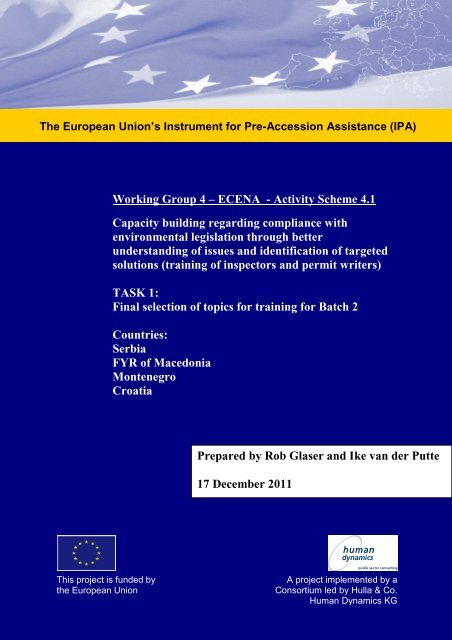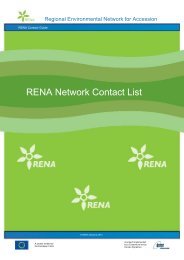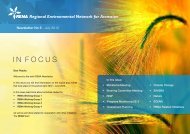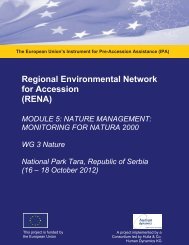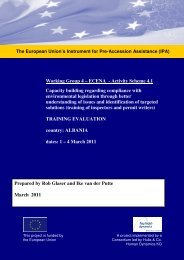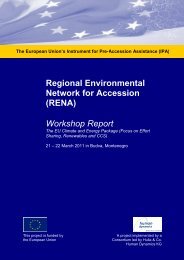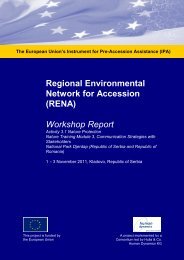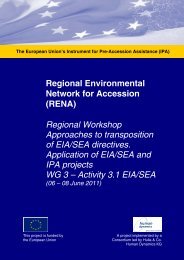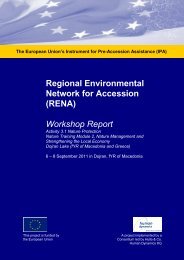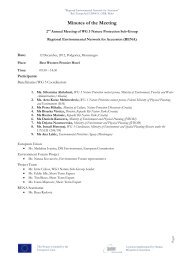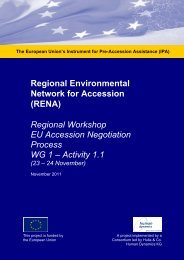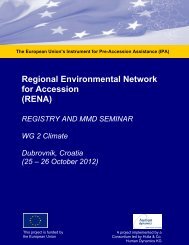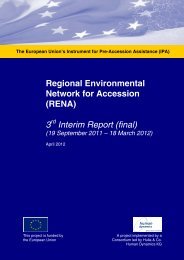RENA WG 4 Dec 2011 final assessment needs ... - Renanetwork.org
RENA WG 4 Dec 2011 final assessment needs ... - Renanetwork.org
RENA WG 4 Dec 2011 final assessment needs ... - Renanetwork.org
- No tags were found...
You also want an ePaper? Increase the reach of your titles
YUMPU automatically turns print PDFs into web optimized ePapers that Google loves.
Working Group 4 – ECENA - Activity Scheme 4.1Capacity building regarding compliance with environmentallegislation through better understanding of issues andidentification of targeted solutions (training of inspectors andpermit writers)Final Selection of Topics for Training (Batch 2)Table of Contentspage1. Introduction 22. Objectives 23. General Approach 24. Selection of participants 35. Training subjects 3Report prepared by:Rob Glaser, Senior Technical Expert, Permitting and InspectionIke van der Putte (<strong>RENA</strong> Team Leader and coordinator <strong>WG</strong> 4 – ECENA)Contact:Dr. Ir. Ike van der PutteTel: +31 15 750 16 00Mob: +31 653 948 067Fax: +31 15 750 1610e-mail: ike.van.der.putte@renanetwork.<strong>org</strong>This project is funded by the European Union.<strong>RENA</strong> Secretariat: Hulla & Co. Human Dynamics KG; Lothringer Strasse 16, 1030 Vienna (Wien), AustriaTel: +43 1 402 50 21 12; Fax: +43 1 402 50 20 20; email: rena.secretariat@renanetwork.<strong>org</strong>Website: www.renanetwork.<strong>org</strong>
SERBIA (Attachment 1 questionnaire)Background information from the commission (PROGRESS REPORTS 2009 - <strong>2011</strong> and recentreport in the framework of <strong>RENA</strong> <strong>WG</strong>4 of <strong>2011</strong>)Serbia has moderately advanced in the area of environmental protection, and has continued to adopt anumber of important laws thereby advancing well in fulfilling the requirements of the SAA.The MEMSP is responsible for the implementation of the environmental acquis. This understanding of“implementation” seems to arise from the use of the EU “Implementation Questionnaires” to assessprogress. “Practical” implementation by the national system lags behind the reported “legal”implementation and progress in practical implementation is slow.The Serbian Environmental Protection Agency has maintained a good level of cooperation with theEuropean Environment Agency on the European environment information and observation network.However, the rules on environmental impact <strong>assessment</strong> and strategic impact <strong>assessment</strong> are not fullyenforced. The environmental departments at local level still lack the necessary capacity, awareness andspecialist knowledge in these fields. Progress can be reported on waste management.On industrial pollution control and risk management, a number of by-laws were adopted, notably onsubmission of integrated permit applications. The first integrated permits are issued in 2009 to 2010.The list of installations which will have to comply with the Integrated Pollution Prevention and ControlDirective before 2015 is being revised. However, while the majority of permits will be issued by thecentral and the Autonomous Province authorities, permits for some industries fall within the remit of localgovernment, which lacks both the knowledge and the resources to implement the IPPC Law.In summary it can be said that there seems to be reasonable coordination between IPPC and the Laws onAir, Waste and Noise but there is limited coordination between IPPC and the Law on Planning andConstruction, and the Law on Water.IPPC and in the future IED requirements will have to be absorbed in the implementation, as they addressthe requirement to use BAT. In the MATFWM permits and licences are issued for the discharge ofwastewater. In addition EIA and building permits are issued with MEMSP. Activities are not adequatelycoordinated and the present arrangement in relation to water permitting.Positive steps have been taken towards strengthening the administrative capacity. The environmentalprotection inspectorates continued to receive specific training.Role and functions of environmental inspection are established by relevant national legislation. TheRMCEI has been implemented through bylaws. However, it seems that essential changes are needed toreport non-compliance and how any non-compliance has been corrected and the steps taken to avoidrecurrence. Another important emphasis of the European legislation is promotion of compliance.The institutional capacity and technical and human resources remain insufficient, especially at local level.Better coordination with the central level is needed and greater attention will have to be paid toenforcement. The Water Directorate within the Ministry of Agriculture, Forestry and Water Managementremains understaffed and its institutional capacity inadequate hence the capacity and capability for properwater management remains weak.The Environmental Protection Agency remains operational and its performance is improving.Although the significant steps have been taken to strengthen inspection services and cooperation withcompetent judicial institutions intensification related measures are needed. Parallel to this,systematically monitoring and upgrading of the system together with incentivemeasures and implementation of voluntary agreements with industry are a prerequisite for improvement.However, it still lacks the capacity to ensure proper implementation of the integrated monitoringstrategy.4
The need for additional staff in most of the institutions involved in implementing the environmental acquisis laid out clearly in the NPI 2008 and in other documents. The level of increase identified as necessaryvaried between Ministries with MEMSP (excluding SEPA and Inspection) planned to increase by 179%,SEPA by 294% and Sector for Control and Surveillance by 20%, giving an overall increase for MEMSP of98% (168 staff).The amended National Programme for Integration of Republic of Serbia into European Union (NPI)from 24 <strong>Dec</strong>ember 2009 once again points out the demand for strengthening and developingadministrative capacities through staff education for performing the following tasks: inspection;monitoring (air, water, land and research); authorization of waste and chemicals management; <strong>assessment</strong>of the impacts and accidents; nature conservation and protection; project management, especially on locallevel where there are not enough environmental conservation officers.Building and strengthening of the permits system include better cooperation between different permitsunits and further training of the stuff. This especially related to the permits which issuing has yet to befully applied in practice.Inception missionSerbia indicated to be interested in receiving info on Environmental Crime in line with its <strong>needs</strong><strong>assessment</strong> report issues like management subjects like, planning, enforcement strategies and noncompliance response.Results QuestionnaireThe results are divided according the sub headings of the questionnaires:Management issues will be emphasized on planning prioritizing, strategies and feedback reporting issuesand inspection issues. The training <strong>needs</strong> have to be fully directed to permit implementation in practicewith site visits and monitoring. Sample taking is considered to be of less importance in the training.Summarising:The training programme has to focus on life inspections on an existing facility and its permit. This can beexecuted during an on site visit, coached by experienced inspectors (see common inspections frominception report). In the preparation of these practical training the subject of permit writing in the contextof the IPPC and IED is practiced and shown how they work. Exercise in Human resources calculationrequired for permit writing and inspection is clarified.The HIP-Elektroliza Petrohemija at Pancevo will be visited with emphasis on Chlorine production andmercury emissions.The special subject requested in the training is IED/IPPC and SOVESO IISuggested composition of the group (max 25) to be trained is as follows:- about 16 participants from the regions involved in industrial inspection and permitting activities as abalanced group.- 4 participants from the ministry of which 2 with knowledge of existing laws and regulations in forceand 2 with knowledge on managerial level in the policy directorate of the ministry.- 2 participants of the ministry that check permits of major industries prior to the issuance of the permit inthe regions.- 2 so called “common inspectors” from other countries with specific knowledge on this type factory tobe attending.Training schedule for 6-9 March 2012Training programmeDay 1: INTRO; INTERACTIONS REGULATORY CYCLE, MANAGEMENT OF INSPECTIONSand LATEST SOFTWARE; PRIORITY SETTING; REPORTING AND FEEDBACK; BASICS OF5
PERMITTING; EXERCISE IN HUMANRESOURCE MANAGEMENT for permitting andinspection; SPECIAL SUBJECTS (IED and IPPC)Day 2: IED(recent developments); DISCUSSION ON CONTENTS OF PERMIT APPLICATIONS;INTEGRATED PERMITTING (example pertro-chemical industry); STUDY ON THE BREFAND/OR BAT (applied at Chlorine production industry at HIP-Elektroliza Petrohemija Pancevo;RESENTATION ON FACILITY TO BE INSPECTED BY REPRESENTATIVE OF THEFACTORY; Exercise on mercury emission mass balance and validation of data); BASICS ONAPPROACH TO SITE VISITS; PLANNING OF THE VISIT IN GROUPS; PRESENTATION OFEXPERIENCE OF THE INVITED INSPECTORS.Day 3: EXECUTION PLANNED VISIT; PREPARATION OF REPORT ON RETURN;PRESENTATION OF RESULTS OF THE VISIT; FINAL CONCLUSION; ADVISE FORFOLLOW-UPDay 4: SPECIAL SUBJECT OF THE BENEFICIARY COUNTRY IPPC and IED; SEVESO II.OPEN DISCUSSION ON COOPERATION BETWEEN AUTHORITIESAttachment 1 Serbia questionnaireNeeds questionnaireTraining Area Topics Priority Ranking1 = urgent; 2 = very useful;3 = helpful; 4 = low interestManagementPlanning 1human resource management 2Budgeting 1Prioritizing inspections 1permitting priorities 3non compliance response 2enforcement strategies 1cooperation strategies 2feedback/reporting 1CommentsPermit issuingInspectionYour Suggestions(for specific trainings,and for regionaltrainings, including 2Directives/Regulations of main concern)permit structuresintegrated permittingenforceable conditionsmonitoring requirementsnegotiating skillsmonitoring conditionssite visits 1inspection planning 1reporting 1non compliance response 1investigating skills 1sample taking 4follow-up strategies 1feedback 1IEDSEVESO IIPetro chemicalindustry6
MACEDONIA (Attachment 2 questionnaire)Background information from the commission (PROGRESS REPORTS 2009 - <strong>2011</strong> and recentreport in the framework of <strong>RENA</strong> <strong>WG</strong>4 of <strong>2011</strong>)Progress has been made towards further transposing the EU acquis in the field of the environment, inparticular for horizontal legislation and waste management. Some sectors, like water quality or IPPC, arestill lagging behind. The pace of institutional strengthening has dropped off somewhat, usually blamed onthe current global economic crisis and a lack of available resources. The weakness of cooperationmechanisms between authorities responsible for related policy areas (and the tradition of verticalintegration in administrations) creates problems of inconsistency, overlap and confusion betweenmanagement procedures. This remains true for the central-local cooperation, as well as cooperationbetween MoEPP and other ministries such as the Ministry of Health. Implementation of the legislationremains a considerable challenge. Administrative capacity is weak at both national and local levels.Significant further efforts are still needed to further align with the EU acquis in this sector and, moreover,to ensure the required investments. Overall, preparations in the field of environment lacks clear progress.Some progress was made in the area of air quality. Transposition in this area is moderately advanced. Thelist of ambient air quality zones and agglomerations was adopted. The inventory of air pollutant emissionsis being compiled, in accordance with the CORINAIR methodology. The administrative capacity is stillweak particularly at local level. Cooperation between the ministries and institutions involved in air qualityis still not sufficient, in particular on collection and analysis of data. Amendments to the WasteManagement Law were enacted, including provisions on sanctions and the level of fines formisdemeanours. The national waste management plan was adopted. Administrative capacity at central andlocal levels is still largely insufficient. Municipal waste management systems have not been set up yet.Investment in this area <strong>needs</strong> to be increased. A system to deal with data collection, registration andreporting is still not in place. Little progress can be reported in the case of water quality. Thetransposition process <strong>needs</strong> to be stepped up.The Administration of Environment is the responsible body for permitting, while SEI is the responsiblebody for supervision/inspection. It is important to remember that inspection information is a valuabletool in permit writing and condition setting; appropriate information exchange and participationprocedures will need to be implemented.Little progress was made on industrial pollution control and risk management. Transposition of theSeveso II Directive on control of major accident hazards involving dangerous substances has progressed.The lack of administrative capacity in this area is a major issue, especially at local level. It results insubstantial delays in issuing IPPC (integrated pollution prevention and control) permits. Training for IPPCinspectors is still not provided. The stakeholders are not sufficiently involved in this process. Theoperators of industrial sites have not yet prepared contingency plans. Significant efforts need to be madein this area. Little progress was made in the area of chemicals (REACH). The EU acquis in this sectorhas still not been transposed. The staff of the national information centre was increased. Some trainingand awareness-raising activities for the institutions and companies concerned have started. Preparations inthis area are at an early stage. Some progress was made in the area of noise. Implementing legislation wasadopted. The administrative capacity is still not sufficient. The units responsible for dealing with noiseissues at central and local levels have not been established yet. Preparations in this area are at an earlystage. The administrative capacity for implementing and enforcing environmental legislation is still farfrom sufficient at both central and local levels. This is particularly true of the inspectorates. The inspectionsystem is understaffed and individual inspectors are required to inspect with respect to all matters and allmedia.Inspectors should be trained to become specialized in areas including IPPC, air, nature, waste, water,SEVESO and chemicals, and hydro-installations, water use and supply. The use of RMCEI is notgenerally introduced and must be speeded together with the new IED. The last one will also have7
considerable impact on inspection and enforcement planning. The country has to implement the new IEDat the same time.Improvement in the quality of the inspection can only be achieved when the quality of the permit and itsconditions are improved at the same time. The latter can only efficiently be improvement when the permitapplication is improved. The latter is the solely responsibility of the enterprises.Reforms to permit procedures will allow more effective inspection, reducing the risks of inconsistentapproaches, conflict of responsibilities and duplication of effort.It will be necessary to ensure that a high level of cooperation is achieved between inspectorates to ensurethis.It should also improve the willingness of operators to collaborate with inspections as their number andthe time spent on them reduces.Combined inspections will also facilitate the introduction of IPPC permit verification; extensive training islikely to be needed to ensure procedures are effective. Existing environmental legislation does notestablish principles for negotiation to complement command and control processes.The coordination between administrative bodies responsible for environment-related issues is not yeteffective. Enforcement of legislation has improved in terms of fines and sanctions, but the system is notyet efficient and no credible record has been established. A command and control approach is used toenforce compliance, with administrative fines specified by law and inspectorates empowered to issue stoporders.More flexibility in tools available to the SEI including compliance orders and the use of economicincentives should be instituted.The environmental monitoring and information system is still not adequate. No funds are foreseen in the2009 budget for new environmental projects., The amount provided is still far from sufficient to meet the<strong>needs</strong>. The national environmental investment strategy was adopted. Environmental protectionrequirements are still not well integrated into policy making and implementation in other areas. Theprecautionary principle, the principle of preventive action and the polluter-pays principle are only partiallyapplied.Inception missionAbout 113 applications of IPPC permits are in more or less advanced state of permitting. In total 130installations are in A (bigger installations), and 150 installations are classified in category B for smallerinstallations.Pilot training in IPPC permitting is in demand. Step by step training is very much needed and all the stepsof the regulatory cycle must be trained. (from Application to permit drafting, compliance monitoringenforcement and feedback).It was agreed that in the IPPC permits not enough attention is paid in the quality of monitoringrequirements. It was mentioned that according to Macedonian IPPC legislation, industry <strong>needs</strong> to fullycomply with the BREFs as from 2016, and at that time the limit values will have to be upgradedResults QuestionnaireThe results are divided according the sub headings of the questionnaires:8
Management issuesThe selection made by the representative of Macedonia shows a clear need for management (ranking 1 asurgent) showing that the overall <strong>org</strong>anization requires additional skills. The emphasis must be put onplanning, budgeting and priority setting on permitting and inspections.The thinking on strategies require a lot of attention indicating an <strong>org</strong>anization in development, while inview of its development minor interest yet in non compliance response and feedback in the managementfield is shown.Permit issuingEnforceable permit conditions and monitoring requirements are high on the list (rating 1) in line with theresults in the inception meeting. So the quality of the permits including monitoring conditions is rightlychosen in the preparation of the future quality of the <strong>org</strong>anization. A solid base for the future is chosenabove sophistication in structures and conditions.Inspection issuesIn line with the request in the permitting quality (ranking 1) the request for investigating skills also fitswith planning, reporting and sample taking.It looks like that the Macedonia <strong>org</strong>anization is building up a very practical directly applicable way ofworking coping with very limited in capacity and quality.The time of non compliance response and follow-up strategies still has not arrived.SummarisingIn the preparation of these practical training the subject of permit writing in the context of the IPPC andIED is practiced and shown how they work. For the future the contents of BREFs and BAT have to bestressed especially in the field of enforceable permit conditions in which monitoring and reporting need tobe amply placed.The training programme has to focus on life inspections on an existing facility and its permit. This can beexecuted during a on site a visit, coached by experienced inspectors. The installation to be visited is anElectrical Arc Steel factory.The special subject requested in the training is on IPPC or LCP’s.An Electrical Arc steel furnace factory will be visited in the area of Skopje.A suggestion of the composition of the group to be trained is as follows:Central government inspectors and inspectors of the regions not exceeding 25 should be invited. Abalanced number of permit writers included.- 2 so called “common inspectors” from other countries with specific knowledge on the factory to bevisited;- Training schedule is planned for 24-27 of April 2012Training programmeDay 1: INTRO; INTERACTIONS REGULATORY CYCLE, MANAGEMENT OF INSPECTIONS;PRIORITY SETTING; REPORTING AND FEEDBACK, BASICS OF PERMITTING, EXERCISEIN HUMANRESOURCE MANAGEMEN and LATEST SOFTWARE T; PLANNING OFINSPECTIONS; NEGOTIATING SKILLSDay 2: IED(recent developments); DISCUSSION ON CONTENTS OF PERMIT APPLICATIONS;INTEGRATED PERMITTING (example Electrical Arc steel factory); STUDY ON THE BREFAND/OR BAT (applied at the Electr Arc Furnace industry); PRESENTATION ON FACILITY TO BEINSPECTED BY REPRESENTATIVE OF THE FACTORY; BASICS ON APPROACH TO SITEVISITS; PLANNING OF THE VISIT IN GROUPS; PRESENTATION OF EXPERIENCE OF THEINVITED INSPECTORS9
Day 3: EXECUTION PLANNED VISIT; PREPARATION OF REPORT ON RETURN;PRESENTATION OF RESULTS OF THE VISIT; FINAL CONCLUSION; ADVISE FORFOLLOW-UP ;PRESENTATION DF RESULTS OF THE VISITDay 4: OPEN DISCUSSION ON COOEPREATION BETWEEN AUTHORITIES. Special subjectREACHAttachment 2 MacedoniaNeeds QuestionnaireTraining Area Topics Priority Ranking1 = urgent; 2 = very useful;3 = helpful; 4 = low interestManagementPlanning 1human resource management 1Budgeting 1prioritizing inspections 1permitting priorities 1non compliance response 2enforcement strategies 1cooperation strategies 2feedback/reporting 2CommentsPermit issuingInspectionpermit structures 3integrated permitting 2enforceable conditions 1monitoring requirements 1negotiating skills 1monitoring conditions 1site visits 1inspection planning 1reporting 2non compliance response 2investigating skills 1sample taking 1follow-up strategies 2feedback 1Your Suggestions(for specific trainings,and for regionaltrainings, including 2Directives/Regulations of main concern)REACHVisit to EAF factory10
MONTENEGRO (Attachment 3 questionnaire)Background information from the commission (PROGRESS REPORTS 2009 - <strong>2011</strong> and recentreport in the framework of <strong>RENA</strong> <strong>WG</strong>4 of <strong>2011</strong>)Montenegro has made some progress on legislative alignment with European standards. Deadlines fortransposition contained in the NPI and the Progress Monitoring reports are subject to slippage. Severalpieces of legislation were scheduled for transposition by the end of 2009, and although these deadlineshave not been met, the schedule to extend these deadlines has not been revised. Moreoverimplementation and enforcement need to be strengthened considerably.Some progress has been made as regards horizontal legislation. The government adopted a nationalenvironmental policy setting out national priorities and addressing cross-cutting issues, such as the need tobring gradually all environmental protection issues together under a single ministry. Further alignment ofthe relevant environmental legislation with the acquis is has not really advanced since 2009. Particularattention <strong>needs</strong> to be paid to strengthen administrative capacity and to establish effective inspectionservices.Serious efforts are required to further improve on permitting and enforcement of legislation.As EIA is a part of the decentralization process, an important focus should be on building the capacitiesof the LSGUs, bearing in mind that the closer the authority is to the population, the more likely itsprocedures and decisions are to be understood and therefore effective.Its use as a basis for or tool in integrated permitting and accident prevention and control processeshas to be increased, in line with IMPEL proposals on the subject.Emissions are traditionally covered through a media-based system of fees and charges. These aregradually being replaced by a system of integrated permitting based on self-reporting and self-monitoring.Steady progress should be made in extending integrated permitting to more industries and more facilities,through a comprehensive review of environmental permitting with a view to simplifying processes. Otherauthorities issuing related permits need to participate in order to overcome discrepancies between regimesbut also to see whether further rationalisation could be achieved.It is important to ensure sufficient separation between the units within EPA that deal with permitting andinspections. When doing so, it will be important to remember that inspection information is a valuabletool in permit writing and condition setting.The inspection system is understaffed and individual inspectors are required to inspect with respect to allmatters and all media, with the exception of the special regime of water inspection.Inspectors should be trained to become specialized in areas including IPPC, air, nature, waste, water,SEVESO and chemicals, and hydro-installations.Reforms to permit procedures will allow more effective inspection, reducing the risks of inconsistentapproaches, conflict of responsibilities and duplication of effort.It will be necessary to ensure that a high level of cooperation is achieved between inspectorates to ensurethis. This is already provided by the Law on Inspection Control but attention must be paid topractical implementation.Combined inspections will also facilitate the introduction of IPPC permit verification; extensive training islikely to be needed to ensure procedures are effective.In the area of air quality, considerable work is under way, but little tangible progress has been achieved inmaking data available to the public. Limited progress can be reported on water quality. A Law on WaterManagement and Financing was adopted. Some progress can be reported on industrial pollution control11
and risk management, especially in in aligning with the Waste Incineration and Solvents Emissionsdirectives. The Convention on Transboundary Effects of Industrial Accidents was ratified. There was noprogress in the areas of chemicals. Preparations in these relevant legislation, but implementation andenforcement remain challenges are at an early stage. There was no progress on noise abatement.Following establishment of the new government, responsibility for the environment and spatial planningwas assigned to the new Ministry of the Environment and Spatial Planning,. An Environmental ProtectionAgency (EPA), with a wide range of responsibilities was established by government decree. So far theEPA has employed 56 permanent staff out of the 80 or so planned. The limited resources of the EPAraise serious concerns about the ability of the new agency to perform its functions. Coordination betweenthe bodies involved in environmental protection issues, particularly in inspection activities, <strong>needs</strong> to beimproved. There has been a considerable increase in the number of inspections conducted by theecological inspectorate. However, the lack of implementation capacity at local level and poorcoordination between central and local government are continuing to limit enforcement capacity.The RMCEI 2001/331/EC recommendation applies to environmental inspections of all industrialinstallations and other enterprises and facilities, whose air emissions and/or water discharges and/or wastedisposal or recovery has to be implemented and even be adjusted to the new IED regulating which amongothers stipulates the frequency of inspection and reporting.Whilst it does not explicitly state it, the RMCEI assumes that “environmental inspections” cover allprincipal media in a coherent way. This can best be achieved through an integrated approach tocompliance control, supporting the integrated approach to permitting.The effect of the current fragmentation of permit requirements across media and processes make itdifficult to ensure a coherent approach to compliance standards and fails to provide the correct incentivesand signals to operators.Inception missionBeing a new <strong>org</strong>anisation EPA require and requested training of the new staff. The emphasis must be puton permitting and inspection.The proposed programme under <strong>WG</strong> 4 is fully accepted with the training on practical issues and not inclassrooms.For preparing a pilot IPPC permit Montenegro suggest three possible pilot visits for the training viz.:1. Pljevlja thermal power plant. 250 MWe.2. Landfills3. Cement industryResults QuestionnaireManagementThe emphasis is put on priority setting on permitting and non compliance response, which is in line withthe development of the new ministry.The thinking on strategies requires a lot of attention for an <strong>org</strong>anization in development, however in viewof the lack of personnel practical hands on experience is more understandable. Once the practicalexperience is gained the need for more structures and strategies will be footed on experience of availablecapacities and capabilities of the personnel. The financial possibilities will then determine the progresspotential.Permit issuingEnforceable permit conditions, monitoring requirements and monitoring conditions rightly have a ranking1 in balance with the limited possibilities in the country to enforce. So the quality of the permits includingmonitoring conditions is chosen in the preparation for the future. Permit structures apparently are yet of alesser importance, although one could introduce in an early stage risk based management in prioritisingpermits issuing.12
InspectionThe suggestions made in the questionnaire show a high rating (1) on non compliance response andinvestigating skills. They are in bid in conflict with the ratings on sample taking follow-up and feedbackand reporting.In agreement with the need for practical hands on training is the interest expressed in the site visitSummarisingIn the preparation of these practical training the subject of permit writing and enforceable permitconditions in the context of the IPPC and IED will be practiced and is shown how they work. Thenegotiating part will be focused on the contents of BREFs and BAT for example on the power industry(LCP’s).The training programme has to focus on life inspections on an existing facility and its permit. This visitwill be executed and coached by experienced inspectors. The installation to be visited is thermal powerplant.The special subject requested in the training is IPPC for the power plant.The large combustion plant industry at Pljevlja will be visited.Suggested composition of the group (max 25) to be trained is as follows:- max of 12 participants from the regions involved in industrial inspection and permitting activities- 4 participants from the ministry of which 2 with knowledge of existing laws and regulations in force and2 with knowledge on managerial level in the policy directorate of the ministry.- 2 participants of the ministry that check permits of major industries prior to the issuance of the permit inthe regions.- 2 so called “common inspectors” from other countries with specific knowledge on this type factory tobe attending.The suggestion is to have planning and budgeting specialists from the ministry of Environment and/orentities while furthermore participants in the field of actual permit writing either from the entities ormajor cantons involved with and submitting permits and controls. Institution representatives involvedwith monitoring might be considered as well. The emphasis should be placed upon active fieldparticipants rather than administrative participants.The training is scheduled for 4- 7 September- 2012Training programmeDay 1: INTRO; INERACTIONS REGULATORY CYCLE, MANAGEMENT OF INSPECTIONS;PRIORITY SETTING; REPORTING AND FEEDBACK, BASICS OF PERMITTING, EXERCISEIN HUMANRESOURCE MANAGEMENT and LATEST SOFTWARE; PLANNING OFINSPECTIONS; SPECIAL SUBJECTS -Waste management landfillsDay 2: IED(recent developments); DISCUSSION ON CONTENTS OF PERMIT APPLICATIONS;INTEGRATED PERMITTING (example LCP Pljevlja industry); STUDY ON THE BREF AND/ORBAT (applied at Pljevlja power plant) PRESENTATION ON FACILITY TO BE INSPECTED BYREPRESENTATIVE OF THE FACTORY; BASICS ON APPROACH TO SITE VISITS;PLANNING OF THE VISIT IN GROUPS; PRESENTATION OF EXPERIENCE OF THEINVITED INSPECTORSDay 3: EXECUTION PLANNED VISIT; PREPARATION OF REPORT ON RETURN;PRESENTATION OF RESULTS OF THE VISIT; FINAL CONCLUSION; ADVISE FORFOLLOW-UPDay 4: SPECIAL SUBJECT OF THE BENEFICIARY COUNTRY IPPC; OPEN DISCUSSION ONCOOPERATION BETWEEN AUTHORITIES13
Attachment 3 MontenegroNeeds QuestionnaireTraining Area Topics Priority Ranking1 = urgent; 2 = very useful;3 = helpful; 4 = low interestManagementPlanning 2human resource management 3Budgeting 3Prioritizing inspections 2permitting priorities 1non compliance response 1enforcement strategies 2cooperation strategies 3feedback/reporting 3CommentsPermit issuingInspectionYour Suggestions(for specific trainings,and for regionaltrainings, including 2Directives/Regulations of main concern)permit structures 3integrated permitting 1enforceable conditions 1monitoring requirements 1negotiating skills 1monitoring conditions 1site visits 2inspection planning 3reporting 3non compliance response 1Investigating skills 1sample taking 3follow-up strategies 3feedback 3Waste directives incineration,landfillVisist to LCPPljevlja14
CROATIA (Attachment 4 questionnaire)Background information from the commission (PROGRESS REPORTS 2009 - <strong>2011</strong> and recentreport in the framework of <strong>RENA</strong> <strong>WG</strong>4 of <strong>2011</strong>)The transposition process is well advanced. A Sustainable Development Strategy has been adopted. TheProtocol on Strategic Environmental Assessment (SEA) to the Convention on Environmental ImpactAssessment in a Transboundary Context (Espoo Convention) was ratified. Efforts to implement the SEAneed to be stepped up. Implementation of provisions relating to public participation and access to justicein environmental matters remains weak. In this respect, cooperation with the judiciary should bestrengthened. Preparations for connection to the EU Emissions Trading Scheme (EU ETS) are welladvanced. The national GHG emission registry remains outstanding. Preparations in this area areproceeding well. The Directive on national emission ceilings for certain atmospheric pollutants is nowfully transposed. Legislation on designation of zones and agglomerations according to categories of airquality was adopted. Establishment of the air quality monitoring and management system is entering itsoperational phase. The Plan for the Reduction of SO2, NOx and Dust Emissions from LargeCombustion Plants and Gas Turbines has been adopted. Further, the National Plan for theImplementation of the Stockholm Convention on Persistent Organic Pollutants has been adopted.Although implementing legislation on limit values for emissions of pollutants into the air from stationarysources and on the quality of liquid fuels has been amended, an annual quantity of fuel that does notconform to prescribed quality standards is still placed on the market. The adjustment of petrol stationsand terminals and modernisation of refineries is ongoing. Some progress has been made in the area ofwaste management. The waste management plan for the period 2007-2015 has been amended toimprove financing and implementation. Implementation of activities aimed at remediation of existinglandfills and the construction of new waste management centres are ongoing. Sustained efforts are neededfor the management of hazardous waste. Implementing legislation relating to the management of wastefrom extractive industries and the management of polychlorinated biphenyls (PCB) and polychlorinatedterphenyls (PCT) was adopted. Amending legislation on the classification of waste and on supervision ofthe transboundary movement of waste was also adopted. Sustained efforts in remediation of existinglandfills and hot-spots and further establishment of systems for collection and management ofdifferent categories of waste are needed. The new Water Act and Act on Water ManagementFinancing have not been enacted yet. This hampers the expected restructuring of the sector andcontinuation of the transposition process, which is slow at the moment. Boundaries of river basins havebeen determined and implementing legislation relating to hazardous substances in waters and waste waterhas been enacted. Monitoring and reporting activities need to be improved. Significant efforts are stillneeded in this area. There has been significant progress in the area of industrial pollution control andrisk management. Implementing legislation relating to the integrated pollution prevention and control(IPPC) and the Seveso II Directives has been enacted. Registries of installations falling under the IPPCand the Seveso II Directives have been established. Efforts have been made in further developing theEuropean Release and Transfer Register (EPRTR). Significant efforts will be required to ensure sufficientadministrative capacity in this sector. Preparations in this area are proceeding well.Good progress can bereported on chemicals. Areas of concern include the nature protection and IPPC sectors. There is a clearneed for institutional strengthening and capacity building at the local level. Given the high level offragmentation of the environment sector across ministries and public bodies, improved coordinationmechanisms and decision-making procedures are requiredInception missionIt is suggested that attention and training should be directed towards IPPC, Basel Convention, andEnvironmental crime in connection with enforcement activities.Capacity building through training on inspection and permitting: through on site pilot training issupported. Case training can be <strong>org</strong>anised in national workshops. Training is requested on RMCEI andIPPC in particular. Training in the anticipated IED is needed A selection of an industry in the process ofapplication for a permit is favoured.15
Results QuestionnaireManagementThe selection made by the representative of Croatia clearly marked planning, prioritizing inspections, noncompliance response, enforcement strategies cooperation, feedback and reporting as rank 1 in themanagement section of the questionnaire. This means that from the ministerial level guidance andstructures still has to be developed.Permit issuingEnforceable permit conditions require maximum attention as rating 1 and combined with monitoring willin order to preserve the quality for the future realizing as rating 2. Monitoring requirements andmonitoring conditions rate a bit lower which is in conflict with the higher rating of enforceable permitconditions.InspectionAll emphasis is to be placed upon the inspection site and the inspectorate functions; like site visits,planning reporting investigating skills follow-up strategies and feedback. Sample taking is rated low in viewof the current way of out sourcing these activities.SummarisingThe training programme has to focus on life inspections on an existing facility and its permit. This visitwill be executed and coached by experienced inspectors. The installation to be visited is a cement industry.The special subject requested in the training is IED, or LCP’s.Suggestions of the composition of the group to be trained is as follows:The participants for the implementation of prevailing regulation should mainly be selected from theregions as well as from some municipalities. In the field of actual permitting a number of permit writersfrom the regions should join together with representatives of the ministry involved either in approvalprocedures for permits and/or actual writing the permits. Max number of participants 25.- 2 so called “common inspectors” from other countries with specific knowledge on the factory to bevisitedThe training schedule is planned for 2-5 of October 2012The industry to be visited is cement industry of Industry Calucem Pula Hrvatska….Training programmeDay 1: INTRO; INTERACTIONS REGULATORY CYCLE, MANAGEMENT OF INSPECTIONS;PRIORITY SETTING; REPORTING AND FEEDBACK, BASICS OF PERMITTING, EXERCISEIN HUMANRESOURCE MANAGEMENT and LATEST SOFTWARE; PLANNING OFINSPECTIONS;ENFORCEMENT STRATEGIES SPECIAL SUBJECTS Waste recovery and/orCleaner ProductionDay 2: DISCUSSION ON CONTENTS OF APPLICATION AND PERMIT; STUDY ON THEBREF AND/OR BAT ON SELECTED INDUSTRY (cement industry in Pula.); PRESENTATIONON FACILITY TO BE INSPECTED BY REPRESENTATIVE OF THE FACTORY; PLANNINGOF THE VISIT IN GROUPS; EXPERIENCE OF THE INVITED INSPECTORS ON THESELECTED FACILITYDay 3: EXECUTION PLANNED VISIT; PREPARATION OF REPORTS RETURN;PRESENTATION OF RESULTS OF THE VISIT; FINAL CONCLUSION; ADVISE FORFOLLOW-UP PRESENTATION OF RESULTS OF THE VISITDay 4: SPECIAL SUBJECT OF THE BENEFICIARY COUNTRY IED (Waste recovery and orcleaner production); OPEN DISCUSSION ON COOPERATION BETWEEN AUTHORITIES16
Attachment 4 CroatiaNeeds QuestionnaireTraining Area Topics Priority Ranking1 = urgent; 2 = very useful;3 = helpful; 4 = low interestManagementPlanning 2human resource management 2Budgeting 2Prioritizing inspections 1permitting priorities 2non compliance response 1enforcement strategies 1cooperation strategies 1feedback/reporting 1CommentsPermit issuingInspectionYour Suggestions(for specific trainings,and for regionaltrainings, including 2Directives/Regulations of mainconcern)permit structures 2integrated permitting 2enforceable conditions 1monitoring requirements 2negotiating skills 2monitoring conditions 2site visits 1inspection planning 1reporting 1non compliance response 1investigating skills 1sample taking 3follow-up strategies 1feedback 1IEDWSR inspectionsPlanning inspection reportingsystems revision of RMCEICement factoryIndustry CalucemPula17


